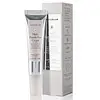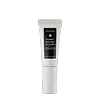What's inside
What's inside
 Key Ingredients
Key Ingredients

 Benefits
Benefits

 Concerns
Concerns

 Ingredients Side-by-side
Ingredients Side-by-side

Water
Skin ConditioningGlycerin
HumectantSimmondsia Chinensis Seed Oil
EmollientStearic Acid
CleansingSqualane
EmollientGlyceryl Stearate
EmollientCetyl Alcohol
EmollientStearyl Alcohol
EmollientPalmitic Acid
EmollientAcetyl Hexapeptide-8
HumectantPalmitoyl Tetrapeptide-7
Skin ConditioningPalmitoyl Tripeptide-1
Skin ConditioningPalmitoyl Tripeptide-5
Skin ConditioningDunaliella Salina Extract
Skin ConditioningPanthenol
Skin ConditioningSodium Hyaluronate
HumectantHydroxyacetophenone
AntioxidantSorbitan Oleate
EmulsifyingAluminum Starch Octenylsuccinate
AbsorbentAcrylamide/Sodium Acryloyldimethyltaurate Copolymer
Emulsion StabilisingPhenoxyethanol
PreservativeButylene Glycol
Humectant1,2-Hexanediol
Skin ConditioningBoron Nitride
AbsorbentCaprylyl Glycol
EmollientTocopheryl Acetate
AntioxidantIsohexadecane
EmollientChlorphenesin
AntimicrobialAcrylates/C10-30 Alkyl Acrylate Crosspolymer
Emulsion StabilisingSodium Hydroxide
BufferingPolysorbate 80
EmulsifyingCarbomer
Emulsion StabilisingSodium Lactate
BufferingPolysorbate 20
EmulsifyingCitric Acid
BufferingEthylhexylglycerin
Skin ConditioningPantolactone
HumectantSodium Benzoate
MaskingPotassium Sorbate
PreservativeWater, Glycerin, Simmondsia Chinensis Seed Oil, Stearic Acid, Squalane, Glyceryl Stearate, Cetyl Alcohol, Stearyl Alcohol, Palmitic Acid, Acetyl Hexapeptide-8, Palmitoyl Tetrapeptide-7, Palmitoyl Tripeptide-1, Palmitoyl Tripeptide-5, Dunaliella Salina Extract, Panthenol, Sodium Hyaluronate, Hydroxyacetophenone, Sorbitan Oleate, Aluminum Starch Octenylsuccinate, Acrylamide/Sodium Acryloyldimethyltaurate Copolymer, Phenoxyethanol, Butylene Glycol, 1,2-Hexanediol, Boron Nitride, Caprylyl Glycol, Tocopheryl Acetate, Isohexadecane, Chlorphenesin, Acrylates/C10-30 Alkyl Acrylate Crosspolymer, Sodium Hydroxide, Polysorbate 80, Carbomer, Sodium Lactate, Polysorbate 20, Citric Acid, Ethylhexylglycerin, Pantolactone, Sodium Benzoate, Potassium Sorbate
Water
Skin ConditioningDimethicone
EmollientIsododecane
EmollientHydrogenated Polydecene
EmollientPropanediol
SolventGlycerin
HumectantIsopentyldiol
HumectantButyrospermum Parkii Butter
Skin ConditioningCaprylic/Capric/Myristic/Stearic Triglyceride
EmollientStearoxymethicone/Dimethicone Copolymer
Emollient3-O-Ethyl Ascorbic Acid
Skin ConditioningCetearyl Olivate
Cetyl Alcohol
EmollientStearyl Alcohol
EmollientSorbitan Olivate
EmulsifyingDimethicone Crosspolymer
Emulsion StabilisingSqualane
EmollientAscorbic Acid
AntioxidantOryza Sativa Bran Extract
Skin ConditioningSorbitol
HumectantMannitol
HumectantRetinol
Skin ConditioningTricaprylin
MaskingAloe Barbadensis Leaf Juice
Skin ConditioningSodium Phytate
Phosphatidylcholine
EmulsifyingRosmarinus Officinalis Leaf Extract
AntimicrobialSodium Ascorbyl Phosphate
AntioxidantHelianthus Annuus Extract
EmollientHyaluronic Acid
HumectantTocopherol
AntioxidantGlutathione
Decyl Glucoside
CleansingGold
Cosmetic ColorantPentaerythrityl Tetra-Di-T-Butyl Hydroxyhydrocinnamate
AntioxidantHdi/Trimethylol Hexyllactone Crosspolymer
Hexadecene
SolventPolymethylsilsesquioxane
Ammonium Acryloyldimethyltaurate/Vp Copolymer
Cetyl Diglyceryl Tris(Trimethylsiloxy)Silylethyl Dimethicone
Emulsion StabilisingPolysilicone-11
Dipropylene Glycol
HumectantCellulose Acetate Butyrate
Caprylyl Glycol
EmollientSilica
AbrasiveXanthan Gum
EmulsifyingCitric Acid
BufferingSilica Silylate
EmollientPotassium Sorbate
PreservativeSodium Benzoate
MaskingMagnesium Stearate
Cosmetic Colorant1,2-Hexanediol
Skin ConditioningSodium Chloride
MaskingPhenoxyethanol
PreservativeWater, Dimethicone, Isododecane, Hydrogenated Polydecene, Propanediol, Glycerin, Isopentyldiol, Butyrospermum Parkii Butter, Caprylic/Capric/Myristic/Stearic Triglyceride, Stearoxymethicone/Dimethicone Copolymer, 3-O-Ethyl Ascorbic Acid, Cetearyl Olivate, Cetyl Alcohol, Stearyl Alcohol, Sorbitan Olivate, Dimethicone Crosspolymer, Squalane, Ascorbic Acid, Oryza Sativa Bran Extract, Sorbitol, Mannitol, Retinol, Tricaprylin, Aloe Barbadensis Leaf Juice, Sodium Phytate, Phosphatidylcholine, Rosmarinus Officinalis Leaf Extract, Sodium Ascorbyl Phosphate, Helianthus Annuus Extract, Hyaluronic Acid, Tocopherol, Glutathione, Decyl Glucoside, Gold, Pentaerythrityl Tetra-Di-T-Butyl Hydroxyhydrocinnamate, Hdi/Trimethylol Hexyllactone Crosspolymer, Hexadecene, Polymethylsilsesquioxane, Ammonium Acryloyldimethyltaurate/Vp Copolymer, Cetyl Diglyceryl Tris(Trimethylsiloxy)Silylethyl Dimethicone, Polysilicone-11, Dipropylene Glycol, Cellulose Acetate Butyrate, Caprylyl Glycol, Silica, Xanthan Gum, Citric Acid, Silica Silylate, Potassium Sorbate, Sodium Benzoate, Magnesium Stearate, 1,2-Hexanediol, Sodium Chloride, Phenoxyethanol
 Reviews
Reviews

Ingredients Explained
These ingredients are found in both products.
Ingredients higher up in an ingredient list are typically present in a larger amount.
1,2-Hexanediol is a synthetic liquid and another multi-functional powerhouse.
It is a:
- Humectant, drawing moisture into the skin
- Emollient, helping to soften skin
- Solvent, dispersing and stabilizing formulas
- Preservative booster, enhancing the antimicrobial activity of other preservatives
Caprylyl Glycol is a humectant and emollient, meaning it attracts and preserves moisture.
It is a common ingredient in many products, especially those designed to hydrate skin. The primary benefits are retaining moisture, skin softening, and promoting a healthy skin barrier.
Though Caprylyl Glycol is an alcohol derived from fatty acids, it is not the kind that can dry out skin.
This ingredient is also used as a preservative to extend the life of products. It has slight antimicrobial properties.
Learn more about Caprylyl GlycolCetyl Alcohol is a fatty alcohol. Fatty Alcohols are most often used as an emollient or to thicken a product.
Its main roles are:
Though it has "alcohol" in the name, it is not related to denatured alcohol or ethyl alcohol.
The FDA allows products labeled "alcohol-free" to have fatty alcohols.
Learn more about Cetyl AlcoholCitric Acid is an alpha hydroxy acid (AHA) naturally found in citrus fruits like oranges, lemons, and limes.
Like other AHAs, citric acid can exfoliate skin by breaking down the bonds that hold dead skin cells together. This helps reveal smoother and brighter skin underneath.
However, this exfoliating effect only happens at high concentrations (20%) which can be hard to find in cosmetic products.
Due to this, citric acid is usually included in small amounts as a pH adjuster. This helps keep products slightly more acidic and compatible with skin's natural pH.
In skincare formulas, citric acid can:
While it can provide some skin benefits, research shows lactic acid and glycolic acid are generally more effective and less irritating exfoliants.
Most citric acid used in skincare today is made by fermenting sugars (usually from molasses). This synthetic version is identical to the natural citrus form but easier to stabilize and use in formulations.
Read more about some other popular AHA's here:
Learn more about Citric AcidGlycerin is already naturally found in your skin. It helps moisturize and protect your skin.
A study from 2016 found glycerin to be more effective as a humectant than AHAs and hyaluronic acid.
As a humectant, it helps the skin stay hydrated by pulling moisture to your skin. The low molecular weight of glycerin allows it to pull moisture into the deeper layers of your skin.
Hydrated skin improves your skin barrier; Your skin barrier helps protect against irritants and bacteria.
Glycerin has also been found to have antimicrobial and antiviral properties. Due to these properties, glycerin is often used in wound and burn treatments.
In cosmetics, glycerin is usually derived from plants such as soybean or palm. However, it can also be sourced from animals, such as tallow or animal fat.
This ingredient is organic, colorless, odorless, and non-toxic.
Glycerin is the name for this ingredient in American English. British English uses Glycerol/Glycerine.
Learn more about GlycerinPhenoxyethanol is a preservative that has germicide, antimicrobial, and aromatic properties. Studies show that phenoxyethanol can prevent microbial growth. By itself, it has a scent that is similar to that of a rose.
It's often used in formulations along with Caprylyl Glycol to preserve the shelf life of products.
Potassium Sorbate is a preservative used to prevent yeast and mold in products. It is commonly found in both cosmetic and food products.
This ingredient comes from potassium salt derived from sorbic acid. Sorbic acid is a natural antibiotic and effective against fungus.
Both potassium sorbate and sorbic acid can be found in baked goods, cheeses, dried meats, dried fruit, ice cream, pickles, wine, yogurt, and more.
You'll often find this ingredient used with other preservatives.
Learn more about Potassium SorbateSodium Benzoate is a preservative. It's used in both cosmetic and food products to inhibit the growth of mold and bacteria. It is typically produced synthetically.
Both the US FDA and EU Health Committee have approved the use of sodium benzoate. In the US, levels of 0.1% (of the total product) are allowed.
Sodium benzoate works as a preservative by inhibiting the growth of bacteria inside of cells. It prevents the cell from fermenting a type of sugar using an enzyme called phosphofructokinase.
It is the salt of benzoic acid. Foods containing sodium benzoate include soda, salad dressings, condiments, fruit juices, wines, and snack foods.
Studies for using ascorbic acid and sodium benzoate in cosmetics are lacking, especially in skincare routines with multiple steps.
We always recommend speaking with a professional, such as a dermatologist, if you have any concerns.
Learn more about Sodium BenzoateSqualane is an emollient that helps the skin hold onto moisture. It's an oily liquid that occurs naturally in certain types of fish and plant oils.
Because squalane boosts hydration in the skin, it also comes with plenty of benefits: it is an antioxidant and can help fight free radicals and skin damage. Squalane is also found to have a detoxifying effect when applied.
Squalane comes from squalene, which occurs naturally within the sebum of our skin. It is one of the oils our skin produces to keep itself hydrated. Squalane is the hydrogenated version of squalene and has a longer shelf life.
Research shows that squalane is non-irritating (even at 100% concentration).
In general, it's a fantastic ingredient. It does a great job at hydrating the skin, and it's suitable for those with sensitive skin.
The source of squalane may impact malassezia / fungal acne. This is because olive oil derived squalane can contain impurities such as fatty acids and plant waxes. Sugarcane derived squalane is recommended for anyone with malassezia concerns.
Is squalane vegan?
This depends on the source. Squalane can be derived from both plants and animals. Most squalane used in skincare comes from plants.
Please note: the source of squalane is only known if disclosed by the brand. We recommend reaching out to the brand if you have any questions about their squalane.
Read more about squalene with an "e".
Is squalane an oil?
Squalane is often called an oil, but it’s technically not; it’s a hydrocarbon, meaning it’s only made of carbon and hydrogen, unlike true oils which are triglycerides made of fatty acids and glycerol.
The term “oil-free” isn’t regulated, so companies can define it however they want. Some exclude all oils, while others just avoid mineral oil or comedogenic oils.
While some people avoid oils thinking they cause breakouts, the right kind of oil (or oil-like ingredient like squalane) can actually help balance and hydrate your skin. It’s worth testing out simple oils or squalane to see what works best for your skin.
Learn more about SqualaneStearyl Alcohol is a type of fatty alcohol from stearic acid. It is a white, waxy compound used to emulsify ingredients.
Fatty Alcohols are most often used as an emollient or to thicken a product. Emollients help soothe and hydrate the skin by trapping moisture.
They are usually derived from natural fats and oils and therefore do not have the same drying or irritating effect as solvent alcohols. FDA allows products labeled "alcohol-free" to have fatty alcohols.
Learn more about Stearyl AlcoholWater. It's the most common cosmetic ingredient of all. You'll usually see it at the top of ingredient lists, meaning that it makes up the largest part of the product.
So why is it so popular? Water most often acts as a solvent - this means that it helps dissolve other ingredients into the formulation.
You'll also recognize water as that liquid we all need to stay alive. If you see this, drink a glass of water. Stay hydrated!
Learn more about Water